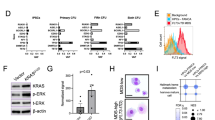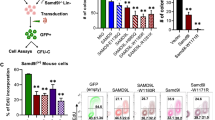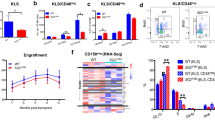Abstract
SALL4 is aberrantly expressed in human myelodysplastic syndromes (MDS) and acute myeloid leukemia (AML). We have generated a SALL4 transgenic (SALL4B Tg) mouse model with pre-leukemic MDS-like symptoms that transform to AML over time. This makes our mouse model applicable for studying human MDS/AML diseases. Characterization of the leukemic initiation population in this model leads to the discovery that Fancl (Fanconi anemia, complementation group L) is downregulated in SALL4B Tg leukemic and pre-leukemic cells. Similar to the reported Fanconi anemia (FA) mouse model, chromosomal instability with radial changes can be detected in pre-leukemic SALL4B Tg bone marrow (BM) cells after DNA damage challenge. Results from additional studies using DNA damage repair reporter assays support a role of SALL4 in inhibiting the homologous recombination pathway. Intriguingly, unlike the FA mouse model, after DNA damage challenge, SALL4B Tg BM cells can survive and generate hematopoietic colonies. We further elucidated that the mechanism by which SALL4 promotes cell survival is through Bcl2 activation. Overall, our studies demonstrate for the first time that SALL4 has a negative impact in DNA damage repair, and support the model of dual functional properties of SALL4 in leukemogenesis through inhibiting DNA damage repair and promoting cell survival.
This is a preview of subscription content, access via your institution
Access options
Subscribe to this journal
Receive 50 print issues and online access
$259.00 per year
only $5.18 per issue
Buy this article
- Purchase on Springer Link
- Instant access to full article PDF
Prices may be subject to local taxes which are calculated during checkout




Similar content being viewed by others
References
Al-Baradie R, Yamada K St, Hilaire C, Chan WM, Andrews C, McIntosh N et al. Duane radial ray syndrome (Okihiro syndrome) maps to 20q13 and results from mutations in SALL4, a new member of the SAL family. Am J Hum Genet 2002; 71: 1195–1199.
Borozdin W, Wright MJ, Hennekam RC, Hannibal MC, Crow YJ, Neumann TE et al. Novel mutations in the gene SALL4 provide further evidence for acro-renal-ocular and Okihiro syndromes being allelic entities, and extend the phenotypic spectrum. J Med Genet 2004; 41: e102.
Kohlhase J, Schubert L, Liebers M, Rauch A, Becker K, Mohammed SN et al. Mutations at the SALL4 locus on chromosome 20 result in a range of clinically overlapping phenotypes, including Okihiro syndrome, Holt-Oram syndrome, acro-renal-ocular syndrome, and patients previously reported to represent thalidomide embryopathy. J Med Genet 2003; 40: 473–478.
Kohlhase J, Heinrich M, Schubert L, Liebers M, Kispert A, Laccone F et al. Okihiro syndrome is caused by SALL4 mutations. Hum Mol Genet 2002; 11: 2979–2987.
Paradisi I, Arias S . IVIC syndrome Is caused by a c.2607delA mutation in the SALL4 locus. Am J Med Genet A 2007; 143: 326–332.
Gao C, Kong NR, Li A, Tatetu H, Ueno S, Yang Y et al. SALL4 is a key transcription regulator in normal human hematopoiesis. Transfusion 2013; 53: 1037–1049.
Warren M, Wang W, Spiden S, Chen-Murchie D, Tannahill D, Steel KP et al. A Sall4 mutant mouse model useful for studying the role of Sall4 in early embryonic development and organogenesis. Genesis 2007; 45: 51–58.
Wu Q, Chen X, Zhang J, Loh YH, Low TY, Zhang W et al. Sall4 interacts with Nanog and co-occupies Nanog genomic sites in embryonic stem cells. J Biol Chem 2006; 281: 24090–24094.
Wang J, Rao S, Chu J, Shen X, Levasseur DN, Theunissen TW et al. A protein interaction network for pluripotency of embryonic stem cells. Nature 2006; 444: 364–368.
Zhang J, Tam WL, Tong GQ, Wu Q, Chan HY, Soh BS et al. Sall4 modulates embryonic stem cell pluripotency and early embryonic development by the transcriptional regulation of Pou5f1. Nat Cell Biol 2006; 8: 1114–1123.
Wang F, Guo Y, Chen Q, Yang Z, Ning N, Zhang Y et al. Stem cell factor SALL4, a potential prognostic marker for myelodysplastic syndromes. J Hematol Oncol 2013; 6: 73.
Ma Y, Cui W, Yang J, Qu J, Di C, Amin HM et al. SALL4, a novel oncogene, is constitutively expressed in human acute myeloid leukemia (AML) and induces AML in transgenic mice. Blood 2006; 108: 2726–2735.
Yang J, Chai L, Liu F, Fink LM, Lin P, Silberstein LE et al. Bmi-1 is a target gene for SALL4 in hematopoietic and leukemic cells. Proc Natl Acad Sci USA 2007; 104: 10494–10499.
Yang J, Chai L, Gao C, Fowles TC, Alipio Z, Dang H et al. SALL4 is a key regulator of survival and apoptosis in human leukemic cells. Blood 2008; 112: 805–813.
Lu J, Ma Y, Kong N, Alipio Z, Gao C, Krause DS et al. Dissecting the role of SALL4, a newly identified stem cell factor, in chronic myelogenous leukemia. Leukemia 2011; 25: 1211–1213.
D'Andrea AD . Susceptibility pathways in Fanconi's anemia and breast cancer. N Engl J Med 2010; 362: 1909–1919.
Seluanov A, Mao Z, Gorbunova V . Analysis of DNA double-strand break (DSB) repair in mammalian cells. J Vis Exp 2010.
Mao Z, Jiang Y, Liu X, Seluanov A, Gorbunova V . DNA repair by homologous recombination, but not by nonhomologous end joining, is elevated in breast cancer cells. Neoplasia 2009; 11: 683–691.
Mao Z, Seluanov A, Jiang Y, Gorbunova V . TRF2 is required for repair of nontelomeric DNA double-strand breaks by homologous recombination. Proc Natl Acad Sci USA 2007; 104: 13068–13073.
Seluanov A, Mittelman D, Pereira-Smith OM, Wilson JH, Gorbunova V . DNA end joining becomes less efficient and more error-prone during cellular senescence. Proc Natl Acad Sci USA 2004; 101: 7624–7629.
Mao Z, Bozzella M, Seluanov A, Gorbunova V . DNA repair by nonhomologous end joining and homologous recombination during cell cycle in human cells. Cell Cycle 2008; 7: 2902–2906.
Muller LU, Milsom MD, Kim MO, Schambach A, Schuesler T, Williams DA . Rapid lentiviral transduction preserves the engraftment potential of Fanca(-/-) hematopoietic stem cells. Mol Ther 2008; 16: 1154–1160.
Oostra AB, Nieuwint AW, Joenje H, de Winter JP . Diagnosis of fanconi anemia: chromosomal breakage analysis. Anemia 2012; 2012: 238731.
Yang Y, Kuang Y, Montes De Oca R, Hays T, Moreau L, Lu N et al. Targeted disruption of the murine Fanconi anemia gene, Fancg/Xrcc9. Blood. Blood 2001; 98: 3435–3440.
Kohlmann A, Kipps TJ, Rassenti LZ, Downing JR, Shurtleff SA, Mills KI et al. An international standardization programme towards the application of gene expression profiling in routine leukaemia diagnostics: the Microarray Innovations in LEukemia study prephase. Br J Haematol 2008; 142: 802–807.
Haferlach T, Kohlmann A, Wieczorek L, Basso G, Kronnie GT, Bene MC et al. Clinical utility of microarray-based gene expression profiling in the diagnosis and subclassification of leukemia: report from the International Microarray Innovations in Leukemia Study Group. J Clin Oncol 2010; 28: 2529–2537.
Bejar R, Stevenson KE, Caughey B, Lindsley RC, Mar BG, Stojanov P et al. Somatic mutations predict poor outcome in patients with myelodysplastic syndrome after hematopoietic stem-cell transplantation. J Clin Oncol 2014; 32: 2691–2698.
Alsner J, Jensen V, Kyndi M, Offersen BV, Vu P, Borresen-Dale AL et al. A comparison between p53 accumulation determined by immunohistochemistry and TP53 mutations as prognostic variables in tumours from breast cancer patients. Acta Oncol 2008; 47: 600–607.
Milsom MD, Schiedlmeier B, Bailey J, Kim MO, Li D, Jansen M et al. Ectopic HOXB4 overcomes the inhibitory effect of tumor necrosis factor-{alpha} on Fanconi anemia hematopoietic stem and progenitor cells. Blood 2009; 113: 5111–5120.
Alpi AF, Pace PE, Babu MM, Patel KJ . Mechanistic insight into site-restricted monoubiquitination of FANCD2 by Ube2t, FANCL, and FANCI. Mol Cell 2008; 32: 767–777.
Gurtan AM, Stuckert P, D'Andrea AD . The WD40 repeats of FANCL are required for Fanconi anemia core complex assembly. J Biol Chem 2006; 281: 10896–10905.
Lensch MW, Tischkowitz M, Christianson TA, Reifsteck CA, Speckhart SA, Jakobs PM et al. Acquired FANCA dysfunction and cytogenetic instability in adult acute myelogenous leukemia. Blood 2003; 102: 7–16.
Hess CJ, Ameziane N, Schuurhuis GJ, Errami A, Denkers F, Kaspers GJ et al. Hypermethylation of the FANCC and FANCL promoter regions in sporadic acute leukaemia. Cell Oncol 2008; 30: 299–306.
Singh TR, Bakker ST, Agarwal S, Jansen M, Grassman E, Godthelp BC et al. Impaired FANCD2 monoubiquitination and hypersensitivity to camptothecin uniquely characterize Fanconi anemia complementation group M. Blood 2009; 114: 174–180.
Rio P, Segovia JC, Hanenberg H, Casado JA, Martinez J, Gottsche K et al. In vitro phenotypic correction of hematopoietic progenitors from Fanconi anemia group A knockout mice. Blood 2002; 100: 2032–2039.
Li A, Yang Y, Gao C, Lu J, Jeong HW, Liu BH et al. A SALL4/MLL/HOXA9 pathway in murine and human myeloid leukemogenesis. J Clin Invest 2013; 123: 4195–4207.
Akashi K, Traver D, Miyamoto T, Weissman IL . A clonogenic common myeloid progenitor that gives rise to all myeloid lineages. Nature 2000; 404: 193–197.
Will B, Siddiqi T, Jorda MA, Shimamura T, Luptakova K, Staber PB et al. Apoptosis induced by JAK2 inhibition is mediated by Bim and enhanced by the BH3 mimetic ABT-737 in JAK2 mutant human erythroid cells. Blood 2010; 115: 2901–2909.
Gao C, Miyazaki M, Ohashi R, Tsuji T, Inoue Y, Namba M . Maintenance of near-diploid karyotype of PA-1 human ovarian teratocarcinoma cells due to death of polyploid cells by chromosome fragmentation/pulverization. Int J Mol Med 1999; 4: 291–294.
Rego MA, Kolling FW 4th, Vuono EA, Mauro M, Howlett NG . Regulation of the Fanconi anemia pathway by a CUE ubiquitin-binding domain in the FANCD2 protein. Blood 2012; 120: 2109–2117.
Huard CC, Tremblay CS, Magron A, Levesque G, Carreau M . The Fanconi anemia pathway has a dual function in Dickkopf-1 transcriptional repression. Proc Natl Acad Sci USA 2014; 111: 2152–2157.
Cui W, Kong NR, Ma Y, Amin HM, Lai R, Chai L . Differential expression of the novel oncogene, SALL4, in lymphoma, plasma cell myeloma, and acute lymphoblastic leukemia. Mod Pathol 2006; 19: 1585–1592.
Acknowledgements
L Chai and W Cui designed the research, analyzed data and wrote the paper. F Wang and C Gao performed the research experiments, analyzed data and wrote the paper. J Lu and H Tatetsu performed the research experiments and analyzed the data. D Williams provided Fanca−/− mice and edited the paper. L Muller performed Fanca−/− mice related experiments. We also want to thank Dr S Xiao for providing DNA repair reporter plasmids, X Yao, and D Neuberg for statistic analysis, X Tian in assisting animal work, and N Kong in editing of the manuscript. This work was supported in part through NIH R03CA184531 and PO1HL095489, funding from Lymphoma and Leukemia Society (No. SLP-8004-14 and TRP-6482-16) and V cancer research Foundation (to L Chai), by the National Natural Science Foundation of China (NSFC) - 81071418 and 81472029 (to W Cui), and China Scholarship Council (No.201206210154) (to F Wang).
Author information
Authors and Affiliations
Corresponding authors
Ethics declarations
Competing interests
The authors declare no conflict of interest.
Additional information
Supplementary Information accompanies this paper on the Oncogene website
Supplementary information
Rights and permissions
About this article
Cite this article
Wang, F., Gao, C., Lu, J. et al. Leukemic survival factor SALL4 contributes to defective DNA damage repair. Oncogene 35, 6087–6095 (2016). https://doi.org/10.1038/onc.2016.146
Received:
Revised:
Accepted:
Published:
Issue Date:
DOI: https://doi.org/10.1038/onc.2016.146
This article is cited by
-
SALL4 is a CRL3REN/KCTD11 substrate that drives Sonic Hedgehog-dependent medulloblastoma
Cell Death & Differentiation (2024)
-
SALL4 as a transcriptional and epigenetic regulator in normal and leukemic hematopoiesis
Biomarker Research (2018)



